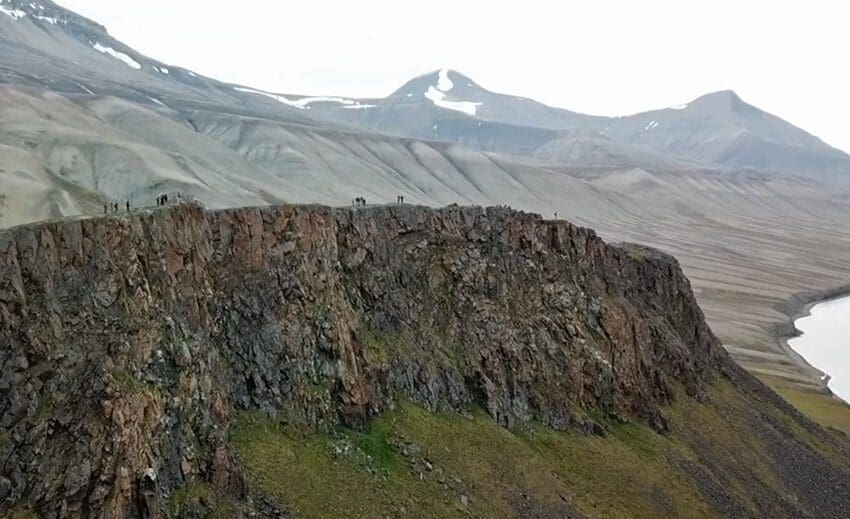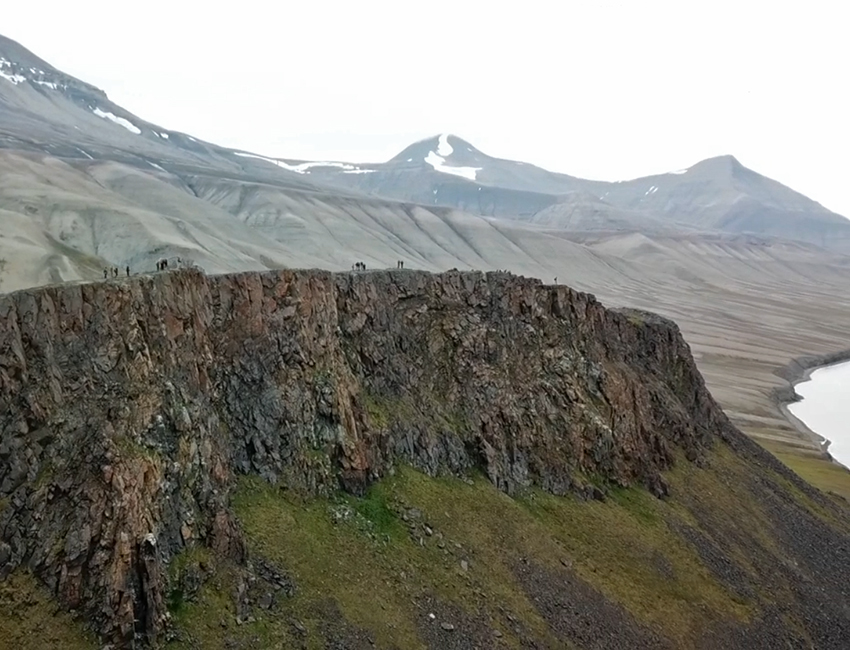AG-851 Arctic Tectonics and Volcanism (10 ECTS)
ID:
AG-851
CREDITS:
10 ECTS
APPLICATION DEADLINE:
October 15, 2023
START DATE:
April 15, 2024
END DATE:
May 31, 2024
COURSE PERIOD:
Spring semester (Block 3: Week 16-22)

Igneous rock close to Diabasodden. Photo: Owen Anfinson
| Grade: | Letter grade (A through F) |
| Course Cost: | Fieldwork, maximum NOK 600,- (3 days x NOK 200,- per overnight stay) |
| Course Capacity Min/Max: | 10/20 students (AG-351/851 in total) |
| Language of instruction: | English |
| Examination support material: | Bilingual dictionary between English and mother tongue |
| Course Leader | Grace Shepard |
Course requirements
Enrollment in a relevant PhD programme. General background in structural geology, sedimentology, volcanology, geodynamics or geophysics. Previous geological field experience is advantageous.
Academic content
This course addresses the diverse geological history of the Arctic region, including both onshore and offshore regions from Paleozoic to recent times. It will focus on the interplay of plate tectonics and volcanism (including, arc, rifting and plume-related) and explore some of the outstanding region-by-region case studies/questions within the Arctic research community. Based in the gateway to the Arctic, Svalbard, the course will be complemented by field excursions examining the well exposed outcrops and specifically the igneous rocks emplaced over large parts of the Svalbard archipelago.
Learning outcomes
The course will present the circum-Arctic region in a 4D perspective: the present-day structure of this region from surface to deep mantle and how it evolved since the Paleozoic. Students will get an overview of the large-scale kinematics and geodynamics of the region in space and time. They will learn how to combine onshore and offshore data to uncover the present-day tectonic structure of the region and use it, together with other knowledge, for plate tectonic reconstructions. The students will learn about causes and manifestation of volcanism in the circum-Arctic region. The course includes field trips to observe present day preservation of past Arctic magmatism.
Upon completing the course, the students will:
Knowledge
- understand the physical, chemical, and structural characteristics of volcanic provinces
- be able to understand plate tectonics principles
- be aware of the links between surface and deep mantle, methods and models using seismology and satellite data
- understand the causal connections between tectonic evolution and episodic bursts of volcanism, as well as the impacts volcanism can have on the global climate.
Skills
- know how to identify first-order tectonic provinces from geophysical and geological data
- be able to make a first order interpretation of geophysical, geochemical, and geological data connected to magmatic provinces
- be able to make plate tectonic reconstructions using modern software
- be able to interpret mantle tomography models and integrate them in large-scale tectonic interpretation
- be able to identify and characterize igneous rocks in the field
- be able to discuss how igneous plumbing systems may affect subsurface fluid migration.
General competences
- gain first-hand experience of actively working both individually and in small groups
- learn how to effectively and safely undertake field work in Arctic conditions
- improve the presentation skills by presenting their work to their peers and creatively tackling the set problems
- communicate their research findings through an article-style report
- gain leadership skills through mentoring fellow students
Learning activities
The course extends over ca. 5 weeks including compulsory safety training, and is run in combination with AG-351 Arctic Tectonics and Volcanism (10 ECTS).
- Pre-course assignment on selected topics and relevant literature that students will present to their peers following arrival at UNIS.
- Overview lectures and exercises at UNIS prior to field work.
- Up to 5 days of field work at relevant localities, mostly as day trips from Longyearbyen.
- Group work at UNIS to work up both pre-existing, provided and freshly acquired data into a research-based project.
- Presentation to the rest of the group.
- Written report summarizing main results in a geology-style article form, to be delivered 1 week after the course ends.
Summary
- Total pre-course reading: 16 hrs
- Total lecture hours: 16 hours
- Total seminar hours: 16 hours
- Total lab hours: 32 hours
- Excursions: Up to 5 days
Compulsory learning activities
All compulsory learning activities must be approved in order to be registered for the final assessment.
- Excursions / field work
Assessment
All assessments must be passed in order to pass the course.
Each assessment is graded, and subsequently combined into a single grade. Partial grades for each assessment will be available.
| Method | Percentage of final grade |
| Pre-course assignment (oral presentation) | 20 % |
| Oral presentation of small research project | 20 % |
| Written report in article form | 60 % |
Student life
The Arctic Tectonics and Volcanism course was developed and funded by the NOR-R-AM project (https://norramarctic.wordpress.com/). The Centre for Earth Evolution & Dynamics at the University of Oslo was in particular instrumental in establishing this course, and many researchers from CEED contributed as guest lecturers on the course, including Grace Shephard, Carmen Gaina and Morgan Jones.
